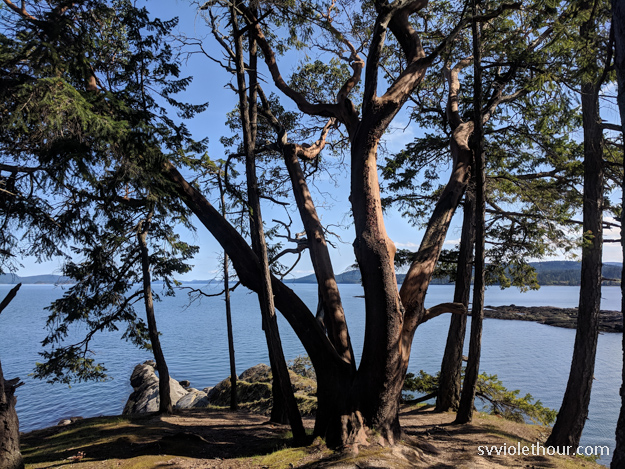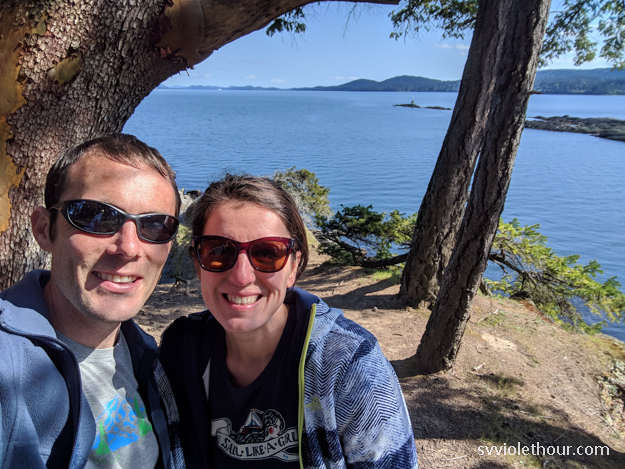Three weeks into our 2019 cruising season, we’re finally feeling in tune with the cruising mindset. Time has started to slow down, and we’re drawn to the peaceful serenity of quiet anchorages. We’re feeling excited for what lies ahead – the snow capped mountain vistas we had sailing up the Strait of Georgia last year, and the welcoming pinnacles of Desolation Sound.
Even the challenge of Johnstone Strait is something to look forward to – will we luck out and get the southeasterly downwind push we had the last two times northbound in Johnstone?
Although this April has been tougher than last year (rainy with rapidly changing wind), the ups and downs of cruising are part of the package. And these early season months are some of my favorites.
Sailability
One reason is due to how much we’re able to sail. So far we’ve done 5 engine hours in 3 weeks since Seattle, and most of that is entering/exiting anchorages or marinas. Actually up till yesterday we hadn’t motored more than 2 miles outside an anchorage / marina. Yesterday we broke that streak by motoring 3 miles when the wind died, getting to Wallace Island. The Pacific Northwest is said to be a place where a lot of motoring is done, but I’ve been saying for a while now that this just isn’t true (except for one month out of the year – August).

By using GRIB models (Windy.com) we’ve been able to time our passages to favorable wind. This is kind of new this year, as prior years we didn’t use Windy quite as much. We checked it for major crossings but now we’re using it pretty much every day. And previously we used it as a secondary source to the government-based marine forecasts but now we use it as the primary wind indicator.
As we entered Canada, we remembered how frustrating we find the Canadian marine forecasts. They have poor accuracy and precision, but also very poor granularity (telling you the time or location the wind will be).
Not only has Windy (the ECMWF model in particular) been more accurate, but perhaps more importantly it provides more precision – timing and strength information that NWS and Environment Canada don’t provide. The government forecasts give wind for “morning”, “afternoon” or “evening” but not specific times. Does evening start at 5pm, or 7pm? Does morning end at noon, or 11am?

The ECMWF gust forecast for Sat April 27. A good example of a very challenging weather model which the ECMWF does a way better job at.
April Cruising Isn’t Easy!
We’ve been a bit demoralized at times this month. It’s seemed much harder than last year’s April – the weather has been tougher (higher winds and more rapidly changing), and lack of sun really weighs on our mood. Even though we know sun cannot be expected daily in the spring in the Pacific Northwest, it sure does help. Dark, rainy days can be hard when living on land, but they’re even harder on a boat at anchor and trying to move each day.
Another factor is we’ve had some boat issues – mostly minor – but time consuming and anxiety inducing nevertheless. Each time I fix something it seems we discover something new that needs fixing. Between sailing, fixing things, and other cruising chores, it all keeps us quite busy and we end up exhausted each day even though we’re not pushing very fast or far.
Basically, cruising is a lot of work. Not news to most of the readers here, but something we easily forget.

The sun finally returned, and we had some great hiking on Wallace Island! Only one other boat with us in Princess Cove.

Ladysmith, BC
One new place we went to is Ladysmith. To the west of Thetis Island, it’s a bit out of the way if you’re heading northbound and trying to sail (typically very little wind gets to the southwest side of Thetis). But we’ve had plenty of wind, and actually need to kill some time before we can cross the Strait of Georgia (because it’s getting forecasts of 25 knots every day – and we know from past experience it can be no fun at all, especially upwind and with wind against current).
Ladysmith is a cute, old town with a logging and coal mining history. Our guidebooks talked it up a lot, but we thought it was maybe a bit overhyped. However it does have a Spice Hut, our favorite Indian restaurant in BC!

We anchored in Sibell Bay, which is about a 1 1/2 mile dinghy ride to the community marina dinghy dock – so you definitely want to have a high speed dinghy or it could take a rather long time.
It was impressive how well protected Ladysmith harbor is from northwest wind. We sailed right up to the harbor entrance in N 15 doing 7 kts on a beam reach and then as soon as we passed a point of land that acts as a wind block, the wind shut down to 0-3. Pretty convenient actually because we were only 0.75 nm from our anchorage and it’s nice to have a non-windy, non-bumpy anchorage (pretty challenging to find in the Gulfs).
Coming Up
When we got to the Gulf Islands we soared into Ganges Harbor on a ripping southeasterly (forecast for 15 kts ended up at 20-25!), and then the weather pattern promptly switched to strong northwesterlies for the foreseeable future (6-7 days). It’s not too bad inside the Gulfs (20-25 in the Strait is 15-20 inside) but we don’t want to be going upwind in 25 out in the Strait for 8-10 hours. We’d also have wind against current at some point, since an upwind crossing is longer than 6 hours.
So we’re waiting out the strong headwinds at the top of the Gulf Islands, till we get a window to cross the Strait to the Sunshine Coast.

